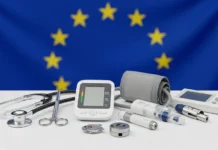The US Food and Drug Administration (FDA) is opening up one of its vast treasure troves of data to the public in the hopes of improving the way medical devices are integrated into the healthcare delivery system.
Background
The latest release involves data related to FDA's unique device identification (UDI) program.
The program, established by regulation in September 2013, requires most medical device manufacturers to affix identifying information to each device they manufacture. The information is intended to help regulators and companies track and trace their devices more easily.
"The unique device identification system will help reduce medical errors, and will allow FDA, the healthcare community, and industry to more rapidly review and assess adverse event reports, identify problems relating to a particular device, and thereby allow for more rapid and effective corrective actions that focus sharply on the specific devices that are of concern," FDA wrote of the UDI program in 2012.
While the UDI is somewhat useful on its own, regulators have long claimed its real potential will be unlocked when the information is tracked using FDA's Global Unique Device Identification Database (GUDID), which is set to act as a repository of information on the devices.
FDA's longstanding goal has been to allow healthcare providers and healthcare delivery systems to link up with its GUDID system, allowing for a transformation in the way care is delivered to patients. For example, a doctor might scan a device code before using a device on a patient, allowing the doctor to see if the device has been recalled, how many devices are supposed to be in the package, whether the device has been discontinued, if the device is safe for use in a MRI machine and to confirm that they have the right device in hand.
New GUDID Database
Now FDA, in partnership with the National Institutes of Health's (NIH) National Library of Medicine (NLM), has released a new open access data website known as AccessGUDID.
"Through AccessGUDID, anyone can search or download information that labelers have submitted about their medical devices to the GUDID," FDA explained in a press statement. "Device identification and key safety information, such as whether the device is safe for use while undergoing MRI, will be available for health care providers to search at any time."
The regulator said it encouraged "everyone—health care systems, clinicians, patients, researchers and industry—to explore its contents, assess its functionality, and provide [FDA] with feedback."
Each device entry in the system contains (example) a vast amount of information about the device, including its characteristics, its approval status, whether it is subject to a recall, instructions for sterilization and handling and the relevant FDA product code.
The agency is accepting feedback on the system, which will help "shape future enhancements, including advanced search and web services."
As FDA notes, the implementation of UDI is not yet complete. The UDI rule is already in effect for most high-risk devices (Class III), but many other devices do not need to comply for several more years. Additional information will be added to the GUDID as it becomes available.
Subscribe
- Never miss a story with notifications
- Gain full access to our premium content
- Browse free from any location or device.
Media Packs
Expand Your Reach With Our Customized Solutions Empowering Your Campaigns To Maximize Your Reach & Drive Real Results!
– Access the Media PackNow
– Book a Conference Call
– Leave Message for Us to Get Back
Related stories
Latest stories
Related stories
Subscribe
- Never miss a story with notifications
- Gain full access to our premium content
- Browse free from any location or device.
Media Packs
Expand Your Reach With Our Customized Solutions Empowering Your Campaigns To Maximize Your Reach & Drive Real Results!
– Access the Media Pack Now
– Book a Conference Call
– Leave Message for Us to Get Back

















